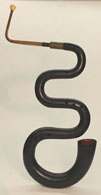
 erpent:
erpent:
Myths and Misconceptions
This instrument “vignette,” arrayed by Craig Kridel, has drawn upon period treatises, contemporary scholarship, and personal impressions. The text is prepared intentionally to move beyond the standard print/web encyclopedia accounts of the serpent. For introductory information about the instrument, please consult Clifford Bevan’s The Tuba Family, the Grove Dictionary of Musical Instruments, and the New Grove Dictionary of Music and Musicians.
****
keyless serpent by
Christopher Monk

Few other wind instruments create such interest and generate such misunderstanding as the serpent. Called a brass instrument and adopted as the emblem of the international tuba association, the serpent is made of wood (albeit, with a metal crook) and is blown with a mouthpiece more similar in size to that of a trombone. Its pitch is altered by opening and closing two sets of three fingerholes and accompanying keys (generally one-to-three). Serpents are open-hole instruments with a conical air-column typically pitched at an eight-foot C2, in contrast to the more commonly known upright serpent, the ophicleide, a closed-hole (keyed) instrument made entirely of metal. When engaged in orchestral performance, the serpent often is scored with bassoons rather than with other low brass instruments.
Much is currently being written about the serpent as researchers and performers seek to appreciate one of the more unusual if not photogenic members of the brass instrument family. Perhaps the most important fact that should be introduced at the onset of any description is that the serpent is not a bass cornetto. The instruments are indeed related, with the cornetto being an end blown, treble instrument made of wood with two sets of three fingerholes; however, Marin Mersenne, a leading 17th century music theorist, organologist, and acoustician, described the serpent not as a bass cornetto but, rather, as the bass member of the cornetto family (maintaining that the serpent and cornetto are linked, and one without the other is similar to a body without a soul). Research clearly determines that the serpent is distinct in terms of use, shape, and construction from what is currently construed as a bass cornetto. [see Resurrecting the Bass Cornetto] Just “what is” a bass cornetto remains somewhat contested as descriptions and a common conception are currently undergoing reconsideration (prompted, in part, from the efforts of Berlioz Historical Brass). Nonetheless, any undergraduate student who is completing a term paper on the serpent will find, quite easily, many so called “authoritative” statements on the internet and in published encyclopedias and texts asserting that the serpent is a bass cornetto. Let it be noted that among low brass scholars the serpent and bass cornetto are considered to be distinctly separate instruments.
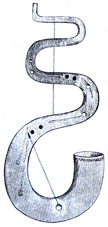
Visit images of a serpent militaire:
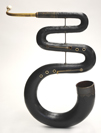
While the differences between these two instruments may be the most overlooked aspect about the serpent, its parentage, birth year, and birthplace represent perhaps the most misconstrued facts in what has now become a popular myth. Many researchers and performers continue to assert as fact that the serpent was invented in Auxerre (the Burgundian region of France) by Canon Edmé Guillaume in 1590. Described as a “convenient myth” by Christopher Monk during his on-stage instrument accounts with the London Serpent Trio in the 1970s and 1980s, the birthing of the serpent may not be quite as precise as many others would wish. The first known reference to the 1590 attribution stems from a 1745 memoir by Abbé Jean Lebeuf, written 155 years after the instrument’s alleged birth. Interestingly, Mersenne’s Harmonie Universelle, published in 1636 and representing a comprehensive overview of musical instruments of that era, makes no reference to Guillaume when discussing the serpent. Mid-18th century publishing records cannot ascertain whether Lebeuf’s work was widely-distributed, yet one can assume that the “serpent was invented in 1590” fact was greatly popularized in the four volume encyclopedia by Jean-Benjamin Laborde, Essai sur la musique ancienne et moderne, published in 1780. By the early 19th century, the serpent’s inventor, birth date, and location—by Guillaume in 1590 at Auxerre—had become “confirmed” and proceeded to be cited in music treatises and instrument histories through to the present day. In fact, organologists are presently making a convincing argument that the 17th century serpent may well have been part of a “cornetto evolution” begun in Italy well before the mythic Auxerre birthing.
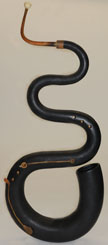
keyed church serpent by Otto Steinkopf

Visit images of a serpent d’eglise
by Forveille
Another misperception about the serpent is that the instrument cannot be played “in tune” and, indeed, in the hands of many presenters, intonation suffers as is similarly the case with the violin when played by amateurs. What is often forgotten by those more versed with the abilities of 19th century instruments is that the serpent cannot fulfil with success expectations of instruments from the Romantic era. This is to say that the serpent, whose intonation does prove challenging to the performer, can still be played well in tune and can blend with woodwinds in ways that other brass instruments cannot; however, what modern listeners may actually find more disconcerting is the serpent’s unevenness of timbre among its various notes, thereby confusing further a sense of pitch to the listener. Clarity of sound, when compared to the consistency of the tuba, suffers; yet, this characteristic is not readily apparent except when the instrument is singled out in a solo demonstration, typically during a stand-up lecture before a performance. While the serpent’s intonation can still be mocked by today’s players of modern instruments, its great tonal flexibility was quite important during an era when fixed pitch was a state “devoutly wished” and when the tuning of certain instruments, most importantly the organ, varied considerably and called for an instrument to be able to play at A=430 or A=460.
The serpent’s initial role, ecclesiastical in nature, was to accompany the choir and to provide stability and volume to the cantus firmus of the chant. This part rarely extended beyond a tenth and fell within the second octave of the serpent where the intonation of many of its notes centered firmly and sounded clearly. While the positioning of the fingerholes on the serpent is indeed acoustically misplaced, a well-versed serpentist could stabilize pitch, maintain some degree of tonal clarity and, equally importantly, engulf the voices of the choristers in what becomes an astonishing blend of sound. Modern demonstrations of the serpent typically portray the instrument by itself, thereby losing the instruments greatly ability to surround sound. Further, such demonstrations often include a moment to display the serpent’s inabilities—typically as a way to relieve the modern player of much responsibility and to undermine any listener’s expectation that the instrument can be played in tune! I recall sitting with Christopher Monk in 1986 at the Amherst Early Music Festival when an historical brass player was describing to us, with great joy, another Englishman, travelling through the United States, who demonstrated his parlour trick of playing an octave on the serpent, first fingering the notes, and then repeating the same musical scale by altering all of the pitches exclusively through lipping without the use of any fingering. Christopher’s retort, knowing all too well this serpent owner, was to note that both scales—lipped and fingered—were dreadful, implying quite clearly that the demonstration displayed the lecturer’s inabilities rather than the serpent’s. For some reason, the serpent continues to attract owners who enjoy mocking what has been an important and useful instrument. In fact, perhaps the serpent’s greatest talent is its tonal flexibility and ability to blend—to produce a warm tone that “surrounds” the voice, as originally conceived in its function of accompanying chant and, in its 19th century role, to blend and to power the sound of the bassoons. Craig Kridel

Visit images of a serpent d’eglise
by Baudouin
What has become apparent during the past years is the need for high density images of serpents.
Visit BHB's photographs of serpents that may be used freely for research purposes.
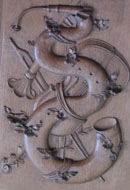


“The arrival of the serpent was well-timed, given the growing need for strength in the cantus firmus sung by the bass voices essential in both chant figure (chant with ornamentation and figuration) associated with the new ‘neo-Gallician’ breviary issued in Paris in 1680, and l’art de fleuretis en chant sur le livre, with its improvised counterpoint. Here the serpent reinforced the requisite strictness of measure to the cantus firmus (itself a radical approach) above which the higher voices improvised their florid melodies, although it is to be noted that the female religious were expressly forbidden to sing ‘the so-called “figured” chant.’”
C. Bevan, The Tuba Family, 2nd edition
(Piccolo Press, 2000, p. 65).
"The serpent was most commonly built in 8-foot C. The compass extends downwards only to C2, but the serpent in a group of instruments can give the impression of an instrument an octave lower. It is not a loud instrument, but it can add a telling effect of depth. As with other brass instruments, there is no upper limit, but from C4 to C5, the tone loses character.”
M. Campbell, C. Greated, & A. Myers,
Musical Instruments (Oxford University Press, 2004, p. 161).
"The pitch of the serpent tends to be unstable owing to its wide conicity and the position of the six finger holes along its ‘S’-shaped tube which are placed conveniently for the three middle fingers of each hand, rather than in accordance with acoustic requirements. When military bands adopted the serpent in the late eighteenth century, three keys were fitted, giving improved Bs, C#s and F#s. The serpent militaire was also more robustly constructed than the serpent d’eglise.”
C. Bevan, “The low brass,” in The Cambridge Companion to Brass Instruments, edited by T. Herbert and J. Wallace (Cambridge University Press, 1997, p. 143).
Rather than attempting to provide a further overview of the serpent in this limited space, the Berlioz Historical Brass website seeks to introduce new information not widely distributed among published and internet sources. What has become apparent during the past years is the need for high density images of serpents.
Presented are photographs of serpents that may be used
freely for research purposes.
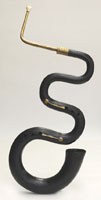
Serpent d’eglise: Church serpent by Baudouin

Serpent militaire: Military serpent

Serpent d’eglise: Church serpent by Forveille

side view of an orchestral serpent

exploring the role of
early 19th century brass
Piccolo Press : ITEA Historical Instrument Section : The Tigers Shout Band : Harmoniemusik : Links
